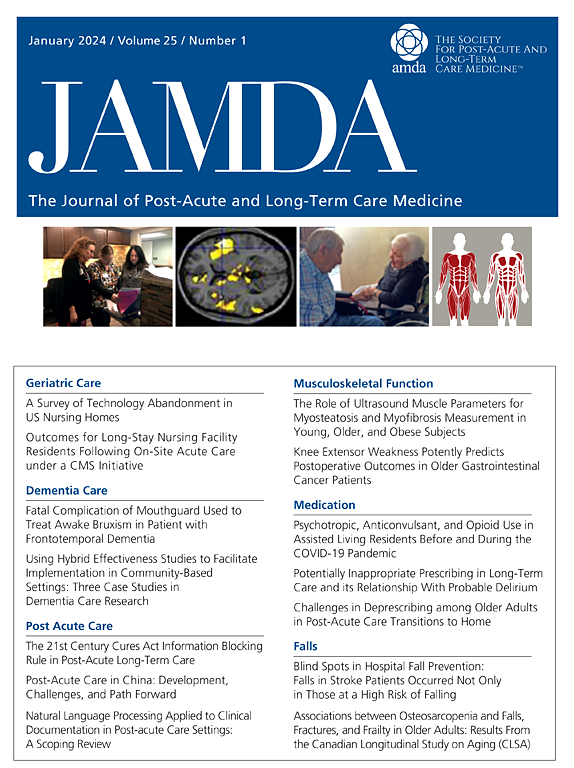智能家居技术预防和检测老年人在社区和住宅护理环境中跌倒的效果评估:系统回顾与元分析》。
IF 4.2
2区 医学
Q2 GERIATRICS & GERONTOLOGY
Journal of the American Medical Directors Association
Pub Date : 2024-11-06
DOI:10.1016/j.jamda.2024.105347
引用次数: 0
摘要
目的:评估智能家居技术(SHTs)在预防和检测社区和养老院老年人跌倒方面的有效性:评估智能家居技术(SHTs)在预防和检测社区和住宅护理环境中老年人跌倒方面的有效性:设计: 对报告了跌倒发生率、跌倒恐惧或住院治疗结果的智能家居技术对照试验进行了系统回顾和荟萃分析。2023 年 8 月,在 6 个学术数据库(PubMed、Cochrane、CINAHL、Scopus、Embase 和 IEEE Xplore)和 2 个灰色文献数据库(ProQuest 和 ClinicalTrials.gov)中对学术文章进行了检索:方法:检索了 8 个数据库(ProQuest 和 ClinicalTrials.gov):2023 年 8 月,我们在 8 个数据库中检索了报告跌倒发生率、跌倒恐惧或住院结果的 SHT 对照试验。两名审稿人独立筛选研究、进行数据提取,并使用乔安娜-布里格斯研究所的关键评估检查表进行质量评估。结果:从数据库搜索中共检索到 12756 项研究;在删除重复和不相关的标题/摘要后,对 46 篇全文进行了研究。共纳入 13 项研究,1941 人参与。其中 2 项被列为低质量研究,5 项被列为中等质量研究,6 项被列为高质量研究。研究发现,SHTs 可显著降低跌倒发生率(RR,0.72;95% CI,0.57-0.93;z = 2.55;P = .01),但对跌倒恐惧的影响不大(标准化平均差,0.19;95% CI,-0.15-0.53;z = 1.11;P = .27),对住院治疗的影响尚无定论:在社区和寄宿护理环境中,SHTs 对降低老年人跌倒发生率、提高安全性和支持老年人独立生活可能有益。未来的研究应开展更多高质量的研究,并使用标准化的结果测量方法。长期居住环境也可以考虑采用SHT预防和检测跌倒,以提高老年人的福祉。本文章由计算机程序翻译,如有差异,请以英文原文为准。
Effectiveness Evaluation of Smart Home Technology in Preventing and Detecting Falls in Community and Residential Care Settings for Older Adults: A Systematic Review and Meta-Analysis
Objectives
To assess the effectiveness of smart home technologies (SHTs) in preventing and detecting falls among older adults in community and residential care settings.
Design
Systematic review and meta-analysis of controlled trials on SHTs, which reported fall incidence, fear of falling, or hospitalization outcomes, was conducted. Searches were conducted across 6 academic databases for scholarly articles (PubMed, Cochrane, CINAHL, Scopus, Embase, and IEEE Xplore) and 2 databases for gray literature (ProQuest and ClinicalTrials.gov) in August 2023.
Setting and Participants
Residents of long-term residential settings ≥60 years of age.
Methods
Eight databases were searched in August 2023 for controlled trials on SHT which reported fall incidence, fear of falling, or hospitalization outcomes. Two reviewers independently screened for studies, performed data extraction, and performed quality assessment using the Joanna Briggs Institute critical appraisal checklists. The RevMan Web was used for meta-analysis.
Results
A total of 12,756 studies were retrieved from the databases search; after removing duplicates and irrelevant title/abstracts, 46 full texts were examined. Overall, 13 studies comprising 1941 participants were included. Two were classified as low quality, 5 were classified as moderate quality, and 6 were classified as high quality. SHTs were found to significantly decrease fall incidences (relative risk, 0.72; 95% CI, 0.57-0.93; z = 2.55; P = .01) but have no significant impact in influencing the fear of falling (standardized mean difference, 0.19; 95% CI, −0.15 to 0.53; z = 1.11; P = .27), and their effect on hospitalization was inconclusive.
Conclusions and Implications
SHTs may be beneficial in reducing fall incidence, enhancing the safety and supporting independent living among older adults in community and residential care settings. Future research should conduct more high-quality studies and use standardized outcome measurements. Long-term residential settings could also consider adopting SHTs for fall prevention and detection to enhance the well-being of older adults.
求助全文
通过发布文献求助,成功后即可免费获取论文全文。
去求助
来源期刊
CiteScore
11.10
自引率
6.60%
发文量
472
审稿时长
44 days
期刊介绍:
JAMDA, the official journal of AMDA - The Society for Post-Acute and Long-Term Care Medicine, is a leading peer-reviewed publication that offers practical information and research geared towards healthcare professionals in the post-acute and long-term care fields. It is also a valuable resource for policy-makers, organizational leaders, educators, and advocates.
The journal provides essential information for various healthcare professionals such as medical directors, attending physicians, nurses, consultant pharmacists, geriatric psychiatrists, nurse practitioners, physician assistants, physical and occupational therapists, social workers, and others involved in providing, overseeing, and promoting quality

 求助内容:
求助内容: 应助结果提醒方式:
应助结果提醒方式:


